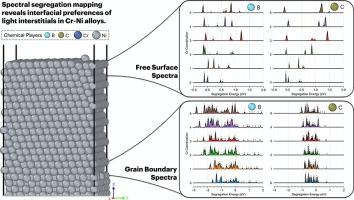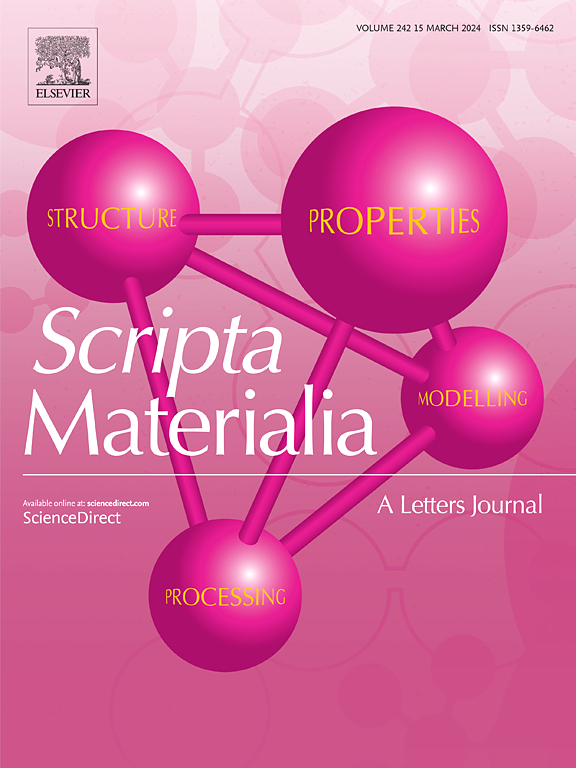Ni中光间隙偏析能的光谱分析:硼和碳的局部Cr配位的作用
IF 5.6
2区 材料科学
Q2 MATERIALS SCIENCE, MULTIDISCIPLINARY
引用次数: 0
摘要
理解化学复杂合金中的间隙偏析需要考虑界面的化学和结构非均质性,激发超越标量描述符的方法,以捕获偏析行为的完整空间和成分光谱。在这里,我们引入了一个光谱偏析框架,将Ni中轻间隙的偏析能的分布映射为局部Cr配位的函数。硼具有宽广、坚固的能谱,具有显著的位置灵活性,而碳仍然局限于具有最小位移的窄能谱。在自由表面,富Cr配位破坏了两个间隙(例如,正偏析能),与Cr在GB上的稳定作用形成鲜明对比。这种反转建立了一个自然的偏析梯度,使间隙远离不协调的内表面,向GBs方向移动。这些结果强调了单值偏析描述符的局限性,并展示了分布方法如何揭示化学非均质合金中间隙-界面相互作用的机制起源。本文章由计算机程序翻译,如有差异,请以英文原文为准。

Spectral analysis of light interstitial segregation energies in Ni: The role of local Cr coordination for boron and carbon
Understanding interstitial segregation in chemically complex alloys requires accounting for chemical and structural heterogeneity of interfaces, motivating approaches that move beyond scalar descriptors to capture the full spatial and compositional spectra of segregation behavior. Here, we introduce a spectral segregation framework that maps distributions of segregation energies for light interstitials in Ni as a function of local Cr coordination. Boron exhibits a broad, rugged energy spectrum with significant positional flexibility whereas carbon remains confined to a narrow spectrum with minimal displacement. At the free surface, Cr-rich coordination destabilizes both interstitials (e.g., positive segregation energies), in sharp contrast to the stabilizing role of Cr at the GB. This inversion establishes a natural segregation gradient that drives interstitials away from undercoordinated internal surfaces and toward GBs. These results underscore the limitations of single-valued segregation descriptors and demonstrate how a distributional approach reveals the mechanistic origins of interstitial–interface interactions in chemically heterogeneous alloys.
求助全文
通过发布文献求助,成功后即可免费获取论文全文。
去求助
来源期刊

Scripta Materialia
工程技术-材料科学:综合
CiteScore
11.40
自引率
5.00%
发文量
581
审稿时长
34 days
期刊介绍:
Scripta Materialia is a LETTERS journal of Acta Materialia, providing a forum for the rapid publication of short communications on the relationship between the structure and the properties of inorganic materials. The emphasis is on originality rather than incremental research. Short reports on the development of materials with novel or substantially improved properties are also welcomed. Emphasis is on either the functional or mechanical behavior of metals, ceramics and semiconductors at all length scales.
 求助内容:
求助内容: 应助结果提醒方式:
应助结果提醒方式:


